American actress and singer Dorothy Lamour (1914-1996) is best remembered for appearing in the Road to... comedies, starring Bing Crosby and Bob Hope. During World War II, Lamour was among the most popular pin-up girls among American servicemen.

French postcard by Erpé, no. 547. Photo: Paramount. Publicity still for The Jungle Princess (Wilhelm Thiele, 1936).

Big German card by Ross Verlag. Photo: Paramount.
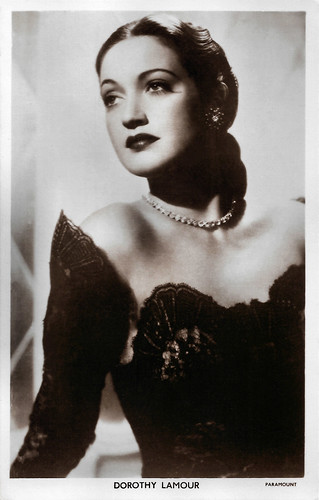
British postcard in the Picturegoer Series, London, no. B. 11. Photo: Paramount.

French postcard by E.C., Rueil-Malmaison, no. 553A. Photo: Paramount. Publicity still for Her Jungle Love (George Archainbaud, 1938).
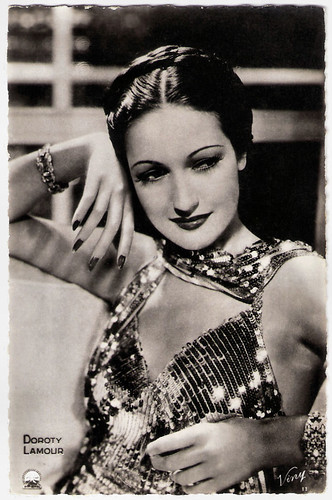
French postcard by Viny, no. 11. Photo: Paramount.
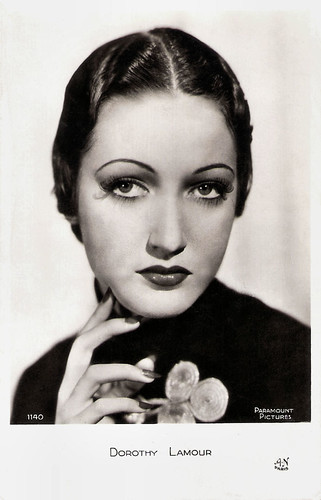
French postcard by A.N., Paris, no. 1140. Photo: Paramount Pictures.
Dorothy Lamour was born Mary Leta Dorothy Slaton in 1914 in New Orleans. She was the daughter of Carmen Louise and John Watson Slaton, both of whom were waiters. Her parents' marriage lasted only a few years. Her mother married for the second time to Clarence Lambour, whose surname Dorothy later adopted and modified as her stage name.
Lamour quit school at age 14. After taking a business course, she worked as a secretary to support herself and her mother. As a teenager, beautiful Dorothy turned heads with her long dark hair. She won the beauty contest Miss New Orleans in 1931 and she headed to Chicago to find work as a singer. For a time, she worked in Chicago as an elevator operator in a department store before going on to become a singer for the big band Herbie Kaye, who became her first husband in 1935. In addition to the band, Dorothy also sang on a Chicago radio program.
In 1936, she moved to Hollywood where she signed with Paramount Pictures. Around that time, Carmen married her third husband, Ollie Castleberry, and the family lived in Los Angeles. Dorothy appeared as jungle native Ulah in The Jungle Princess (William Thiele, 1936) who was raised with a pet tiger among the tropical natives. Ray Milland co-starred as the man from civilisation who woos and wins her. The scene where Milland is trying to teach her the word kiss is a classic, and the film was a money-maker. The film also gave her a hit song 'Moonlight and Shadows'.
Her wrap-around sarong, designed by Edith Head, marked the beginning of her image as the 'Sarong Queen'. Lamour played similar parts in The Hurricane (John Ford, 1937) with Jon Hall, Her Jungle Love (George Archainbaud, 1938) again with Ray Milland, Typhoon (Louis King, 1940), Beyond the Blue Horizon (Alfred Santell, 1942) and her final big-screen sarong feature, Donovan's Reef (John Ford, 1963), starring John Wayne. Although Lamour actually only wore a sarong in six of her 59 pictures, it defined her career.
In 1940, Lamour made her first Road to... comedy film, Road to Singapore (Victor Schertzinger, 1940). The film was a solid hit and the response to the team was enthusiastic. Lamour, Hope and Crosby reunited in Road to Zanzibar (Victor Schertzinger, 1941) which was even more successful and eventually led to a series of seven pictures. The Road to.. films were a combination of adventure, slapstick, as-libbing, romance, and music, and they regularly placed among the top moneymaking films during the 1940s. While the films centred more on Bob Hope and Bing Crosby, Lamour held her own as their 'straight man', and sang some of her most popular songs. She later said: "I was the happiest and highest-paid straight woman in the business."

American postcard by W. J. Gray.
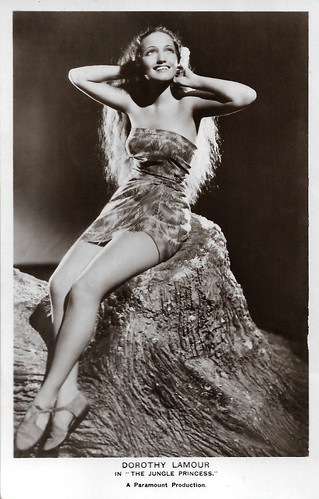
British Real Photograph postcard, London, no. FS 116. Photo: Paramount. Publicity still for The Jungle Princess (Wilhelm Thiele, 1936).
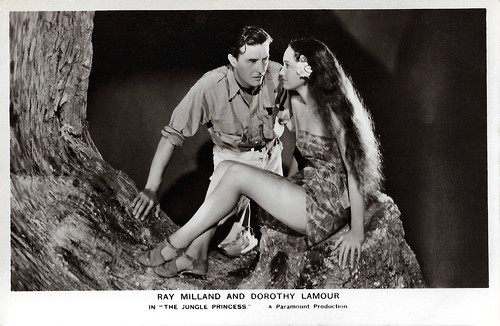
British Real Photograph postcard, London, no. FS 117 Photo: Paramount. Publicity still of Ray Milland and Dorothy Lamour in The Jungle Princess (Wilhelm Thiele, 1936).
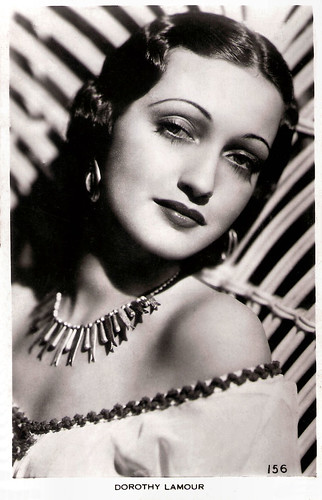
British Real Photograph postcard, no. 156.

British Real Photograph postcard, London, no. FS 179. Photo: Paramount. Ray Milland and Dorothy Lamour in Her Jungle Love (George Archainbaud, 1938).
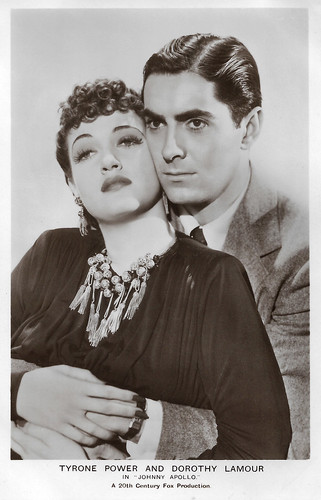
British postcard in the Film Partners Series, London, no. P 325. Photo: 20th Century Fox. Publicity still for Johnny Apollo (Henry Hathaway, 1940) with Tyrone Power.
During World War II, Dorothy Lamour was among the most popular pinup girls among American servicemen, along with Betty Grable, Rita Hayworth, Lana Turner, and Veronica Lake. During World War II, she toured the country, selling more than $300 million worth of war bonds. Lamour could show great range in both comic and dramatic roles. Among her serious films were Disputed Passage (Frank Borzage, 1939) with Akim Tamiroff, the gangster film Johnny Apollo (Henry Hathaway, 1940) starring Tyrone Power, and A Medal for Benny (Irving Pichel, 1945), based on a story by John Steinbeck, co-starring Arturo de Córdova.
In 1947, she was in three big hits in a row: My Favorite Brunette (Elliott Nugent, 1947), a comedy with Bob Hope; Wild Harvest (Tay Garnett, 1947), a melodrama with Alan Ladd; and Road to Rio (Norman McLeod, 1947). She also sang a duet with Ladd in Variety Girl (George Marshall, 1947). Then she left Paramount. Later she was in one more big hit, Cecil B. De Mille's circus epic The Greatest Show on Earth (1952).
The Road to... series essentially ended with the release of Road to Bali (Hal Walker, 1952). By that time, Lamour's screen career began to wane and she focused on stage and television work. In 1961, Crosby and Hope teamed up for one more, The Road to Hong Kong (Norman Panama, 1962), but Joan Collins played the female lead. Lamour made a brief appearance and sang a song near the end of that film. A final Road to... picture, Road to the Fountain of Youth was in the works in 1977, until Bing Crosby's sudden death.
In the 1970s, Lamour revived her nightclub act and, in 1980, she released her autobiography 'My Side of the Road'. She only made ten films between 1951 and 1987. The last one was Creepshow 2 (Michael Gornick, 1987), appearing with George Kennedy as an ageing couple who are killed during a robbery. In 1987, she made her final onscreen appearance in the TV series Murder she wrote with Angela Lansbury.
Dorothy Lamour's first marriage was to orchestra leader Herbie Kay whose big band she sang with. The two married in 1935 and divorced in 1939. Lamour married her second husband, William Ross Howard III, in 1943. They had two sons and remained married until Howard died in 1978. Dorothy Lamour died at her home in Los Angeles in 1996. She was 81. Her stepson William Ross 'Bill, Jr.' Howard IV was born in 1933. Her son John Ridgely 'Ridge' Howard was born in 1946. Her son Richard Thomson 'Tommy' Howard was born in 1949.
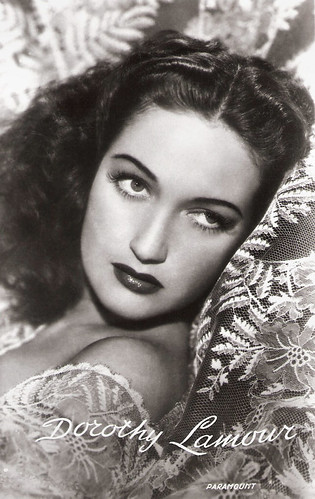
Dutch postcard, no. 3205. Photo: Paramount.
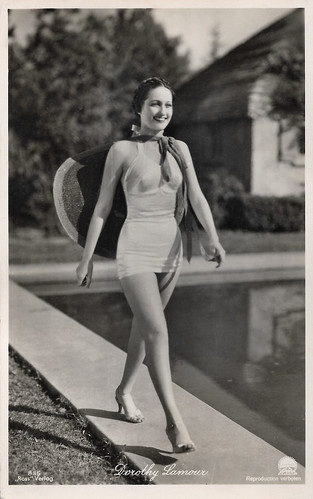
German postcard by Ross Verlag, no. 835. Photo: Paramount.
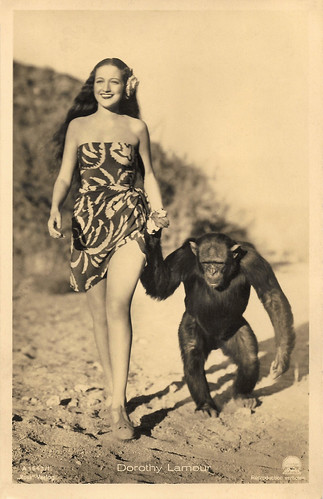
German postcard by Ross Verlag, no. A 1643/1, 1937-1938. Photo: Paramount. Publicity still for The Jungle Princess (Wilhelm Thiele, 1936).
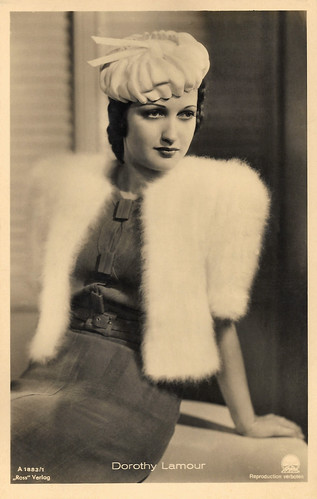
German postcard by Ross Verlag, no. A 1883/1, 1937-1938. Photo: Paramount.
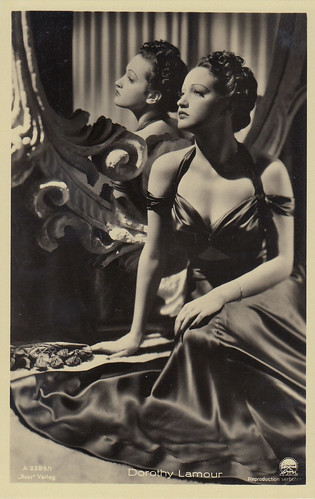
German postcard by Ross Verlag, no. A 2289/1, 1939-1940. Photo: Paramount. Collection: Marlene Pilaete.
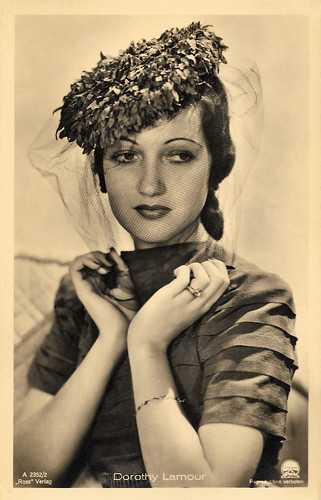
German postcard by Ross Verlag, no. A 2352/2, 1939-1940. Photo: Paramount.
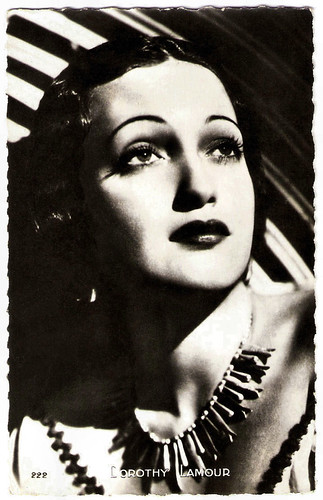
French postcard by Editions P.I., Paris, no. 222.
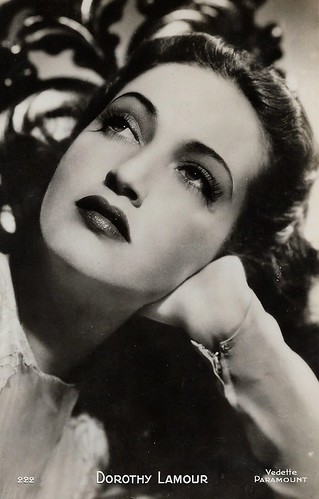
French postcard, no. 222. Photo: Paramount.
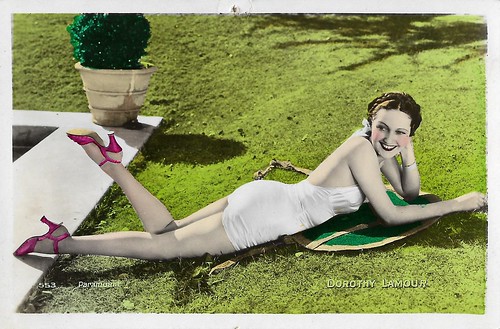
French postcard, no. 553. Photo: Paramount.
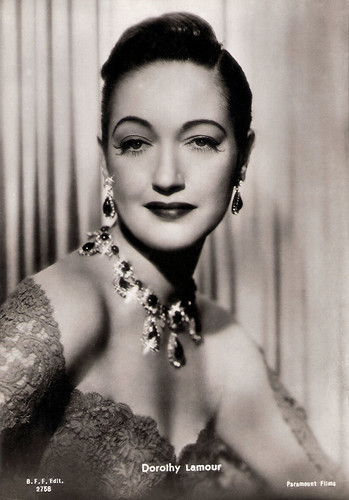
Italian postcard by B.F.F. Edit, no. 2758. Photo: Paramount Films.

Italian postcard by Rizzoli, Milano, 1938. Photo: United Artists.

Dutch postcard, no. 249. Photo: Paramount Pictures / M.P.E.A. Bing Crosby, Bob Hope and Dorothy Lamour in Road to Morocco (David Butler, 1942).
Sources: Denny Jackson (IMDb), Ed Stephan (IMDb), Wikipedia and IMDb.
This post was last updated on 9 February 2025.

French postcard by Erpé, no. 547. Photo: Paramount. Publicity still for The Jungle Princess (Wilhelm Thiele, 1936).

Big German card by Ross Verlag. Photo: Paramount.

British postcard in the Picturegoer Series, London, no. B. 11. Photo: Paramount.

French postcard by E.C., Rueil-Malmaison, no. 553A. Photo: Paramount. Publicity still for Her Jungle Love (George Archainbaud, 1938).

French postcard by Viny, no. 11. Photo: Paramount.

French postcard by A.N., Paris, no. 1140. Photo: Paramount Pictures.
The Sarong Queen
Dorothy Lamour was born Mary Leta Dorothy Slaton in 1914 in New Orleans. She was the daughter of Carmen Louise and John Watson Slaton, both of whom were waiters. Her parents' marriage lasted only a few years. Her mother married for the second time to Clarence Lambour, whose surname Dorothy later adopted and modified as her stage name.
Lamour quit school at age 14. After taking a business course, she worked as a secretary to support herself and her mother. As a teenager, beautiful Dorothy turned heads with her long dark hair. She won the beauty contest Miss New Orleans in 1931 and she headed to Chicago to find work as a singer. For a time, she worked in Chicago as an elevator operator in a department store before going on to become a singer for the big band Herbie Kaye, who became her first husband in 1935. In addition to the band, Dorothy also sang on a Chicago radio program.
In 1936, she moved to Hollywood where she signed with Paramount Pictures. Around that time, Carmen married her third husband, Ollie Castleberry, and the family lived in Los Angeles. Dorothy appeared as jungle native Ulah in The Jungle Princess (William Thiele, 1936) who was raised with a pet tiger among the tropical natives. Ray Milland co-starred as the man from civilisation who woos and wins her. The scene where Milland is trying to teach her the word kiss is a classic, and the film was a money-maker. The film also gave her a hit song 'Moonlight and Shadows'.
Her wrap-around sarong, designed by Edith Head, marked the beginning of her image as the 'Sarong Queen'. Lamour played similar parts in The Hurricane (John Ford, 1937) with Jon Hall, Her Jungle Love (George Archainbaud, 1938) again with Ray Milland, Typhoon (Louis King, 1940), Beyond the Blue Horizon (Alfred Santell, 1942) and her final big-screen sarong feature, Donovan's Reef (John Ford, 1963), starring John Wayne. Although Lamour actually only wore a sarong in six of her 59 pictures, it defined her career.
In 1940, Lamour made her first Road to... comedy film, Road to Singapore (Victor Schertzinger, 1940). The film was a solid hit and the response to the team was enthusiastic. Lamour, Hope and Crosby reunited in Road to Zanzibar (Victor Schertzinger, 1941) which was even more successful and eventually led to a series of seven pictures. The Road to.. films were a combination of adventure, slapstick, as-libbing, romance, and music, and they regularly placed among the top moneymaking films during the 1940s. While the films centred more on Bob Hope and Bing Crosby, Lamour held her own as their 'straight man', and sang some of her most popular songs. She later said: "I was the happiest and highest-paid straight woman in the business."

American postcard by W. J. Gray.

British Real Photograph postcard, London, no. FS 116. Photo: Paramount. Publicity still for The Jungle Princess (Wilhelm Thiele, 1936).

British Real Photograph postcard, London, no. FS 117 Photo: Paramount. Publicity still of Ray Milland and Dorothy Lamour in The Jungle Princess (Wilhelm Thiele, 1936).

British Real Photograph postcard, no. 156.

British Real Photograph postcard, London, no. FS 179. Photo: Paramount. Ray Milland and Dorothy Lamour in Her Jungle Love (George Archainbaud, 1938).

British postcard in the Film Partners Series, London, no. P 325. Photo: 20th Century Fox. Publicity still for Johnny Apollo (Henry Hathaway, 1940) with Tyrone Power.
My side of the road
During World War II, Dorothy Lamour was among the most popular pinup girls among American servicemen, along with Betty Grable, Rita Hayworth, Lana Turner, and Veronica Lake. During World War II, she toured the country, selling more than $300 million worth of war bonds. Lamour could show great range in both comic and dramatic roles. Among her serious films were Disputed Passage (Frank Borzage, 1939) with Akim Tamiroff, the gangster film Johnny Apollo (Henry Hathaway, 1940) starring Tyrone Power, and A Medal for Benny (Irving Pichel, 1945), based on a story by John Steinbeck, co-starring Arturo de Córdova.
In 1947, she was in three big hits in a row: My Favorite Brunette (Elliott Nugent, 1947), a comedy with Bob Hope; Wild Harvest (Tay Garnett, 1947), a melodrama with Alan Ladd; and Road to Rio (Norman McLeod, 1947). She also sang a duet with Ladd in Variety Girl (George Marshall, 1947). Then she left Paramount. Later she was in one more big hit, Cecil B. De Mille's circus epic The Greatest Show on Earth (1952).
The Road to... series essentially ended with the release of Road to Bali (Hal Walker, 1952). By that time, Lamour's screen career began to wane and she focused on stage and television work. In 1961, Crosby and Hope teamed up for one more, The Road to Hong Kong (Norman Panama, 1962), but Joan Collins played the female lead. Lamour made a brief appearance and sang a song near the end of that film. A final Road to... picture, Road to the Fountain of Youth was in the works in 1977, until Bing Crosby's sudden death.
In the 1970s, Lamour revived her nightclub act and, in 1980, she released her autobiography 'My Side of the Road'. She only made ten films between 1951 and 1987. The last one was Creepshow 2 (Michael Gornick, 1987), appearing with George Kennedy as an ageing couple who are killed during a robbery. In 1987, she made her final onscreen appearance in the TV series Murder she wrote with Angela Lansbury.
Dorothy Lamour's first marriage was to orchestra leader Herbie Kay whose big band she sang with. The two married in 1935 and divorced in 1939. Lamour married her second husband, William Ross Howard III, in 1943. They had two sons and remained married until Howard died in 1978. Dorothy Lamour died at her home in Los Angeles in 1996. She was 81. Her stepson William Ross 'Bill, Jr.' Howard IV was born in 1933. Her son John Ridgely 'Ridge' Howard was born in 1946. Her son Richard Thomson 'Tommy' Howard was born in 1949.

Dutch postcard, no. 3205. Photo: Paramount.

German postcard by Ross Verlag, no. 835. Photo: Paramount.

German postcard by Ross Verlag, no. A 1643/1, 1937-1938. Photo: Paramount. Publicity still for The Jungle Princess (Wilhelm Thiele, 1936).

German postcard by Ross Verlag, no. A 1883/1, 1937-1938. Photo: Paramount.

German postcard by Ross Verlag, no. A 2289/1, 1939-1940. Photo: Paramount. Collection: Marlene Pilaete.

German postcard by Ross Verlag, no. A 2352/2, 1939-1940. Photo: Paramount.

French postcard by Editions P.I., Paris, no. 222.

French postcard, no. 222. Photo: Paramount.

French postcard, no. 553. Photo: Paramount.

Italian postcard by B.F.F. Edit, no. 2758. Photo: Paramount Films.

Italian postcard by Rizzoli, Milano, 1938. Photo: United Artists.

Dutch postcard, no. 249. Photo: Paramount Pictures / M.P.E.A. Bing Crosby, Bob Hope and Dorothy Lamour in Road to Morocco (David Butler, 1942).
Sources: Denny Jackson (IMDb), Ed Stephan (IMDb), Wikipedia and IMDb.
This post was last updated on 9 February 2025.
No comments:
Post a Comment